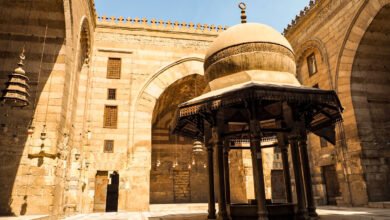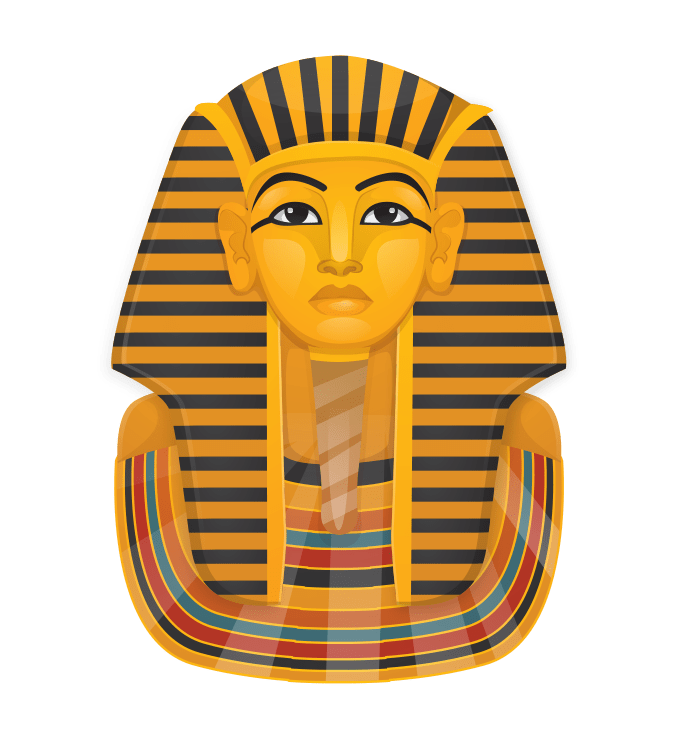The Meidum pyramid, the royal tomb of king Sneferu
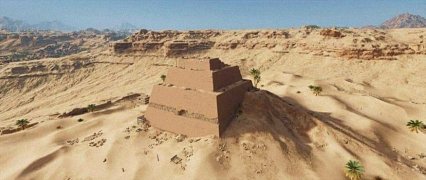
The Meidum pyramid, the royal tomb of king Sneferu
Introduction:
It is one of the pyramids of the Old Kingdom during the reign of King Sneferu of the Fourth Dynasty in Meidum 2620 BC
It is that huge building located in the heart of the desert of Beni Suef Governorate, specifically in the village of Meidum, affiliated with the Wasti Center
in Beni Suef Governorate, as we mentioned before, and scientists have not yet reached the truth of its design and what King Sneferu, the founder of the Fourth Dynasty, was thinking
Who was called the greatest Egyptian builder when he chose this design and was it built in this way

Or was it a complete pyramid before it partially collapsed and was the design the king wanted or was it just a mistake that occurred during construction, so historians believe that the Meidum pyramid will remain a mystery of the ancient Pharaonic state and what can be raised most in the issue of building the Meidum pyramid, which was described as the false pyramid
Is the consensus of Egyptologists and archaeologists that it was built by two kings and not one Egyptian king, as the construction process began
during the reign of King Huni, the last king of the Third Dynasty before it was completed during the reign of King Sneferu, the founder of the dynasty Fourth
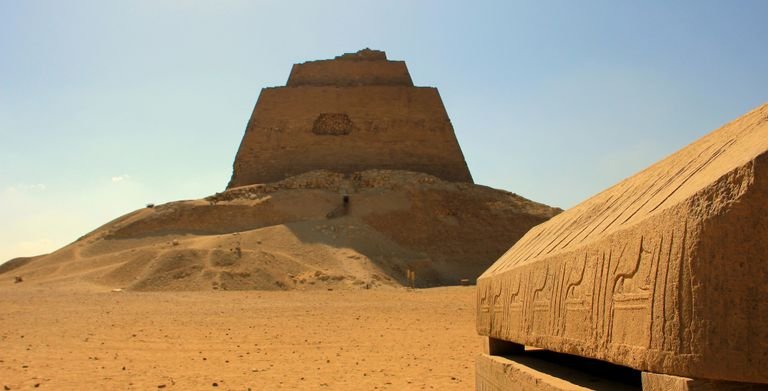
In a complete change in the philosophy of the pharaohs who used to not complete any monuments belonging to the previous kings, some of them even used to erase those monuments that were not completed, and the Meidum pyramid is considered the Egyptian monument that is said to remain a secret of the ancient Pharaonic civilization
The 6 best activities in Safari Park, Cairo
Where this pyramid is distinguished by being the only pyramid that does not take a pyramidal shape, but rather is in the form of a cube and is a transitional stage
Between the step pyramid such as the Pyramid of Djoser and the complete pyramid such as the Pyramid of Khufu, as it is mentioned that it is the first pyramid built in history
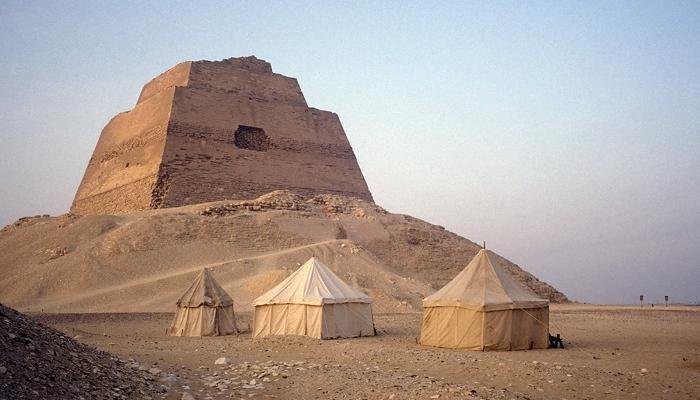
It is the pyramid located next to Memphis on the west bank of the Nile River in Beni Suef Governorate and 100 kilometers south of Cairo Governorate, the capital of Egypt, specifically in the Meidum area affiliated with the city of Al-Wasti, and this Meidum pyramid is distinguished by being the only pyramid that does not take a pyramidal shape
Rather, the Meidum pyramid appears in the form of a cube and the Meidum pyramid located in the desert of the city of Al-Wasti is considered a transitional stage between the step pyramid such as the Pyramid of Djoser in Saqqara and the complete pyramid such as the Pyramid of Khufu in Giza Governorate, meaning that it is the stage The middle ground between the two pyramids, and therefore the unusual shape of the Meidum pyramid attracts the attention of visitors who call it the false pyramid, and Beni Suef Governorate adopted it as its slogan.
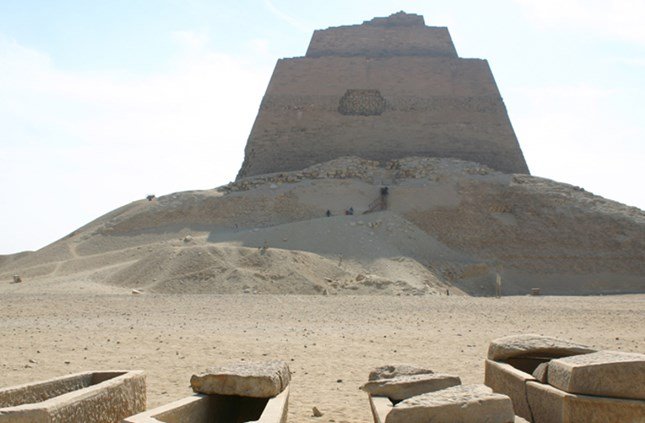
Historical overview:
The Meidum pyramid is located in the village of Meidum, which the ancient Egyptians called Mari Tem, which has the first pyramid complex in a village north of Beni Suef Governorate, 38 km away and 25 km from the Wasti Center. King Huni chose Beni Suef Governorate to build his pyramid complex, which greatly influenced the development of royal tombs in the Old Kingdom. The Meidum pyramid is considered the link between the pyramids listed in the Third Dynasty and the complete pyramid in the Fourth Dynasty.
King Huni, the last king of the Third Dynasty, began building the Meidum pyramid, but King Huni did not complete the construction of the pyramid and died, so his son, King Sneferu, the founder of the Fourth Dynasty, who came to assume the throne, completed it after him.
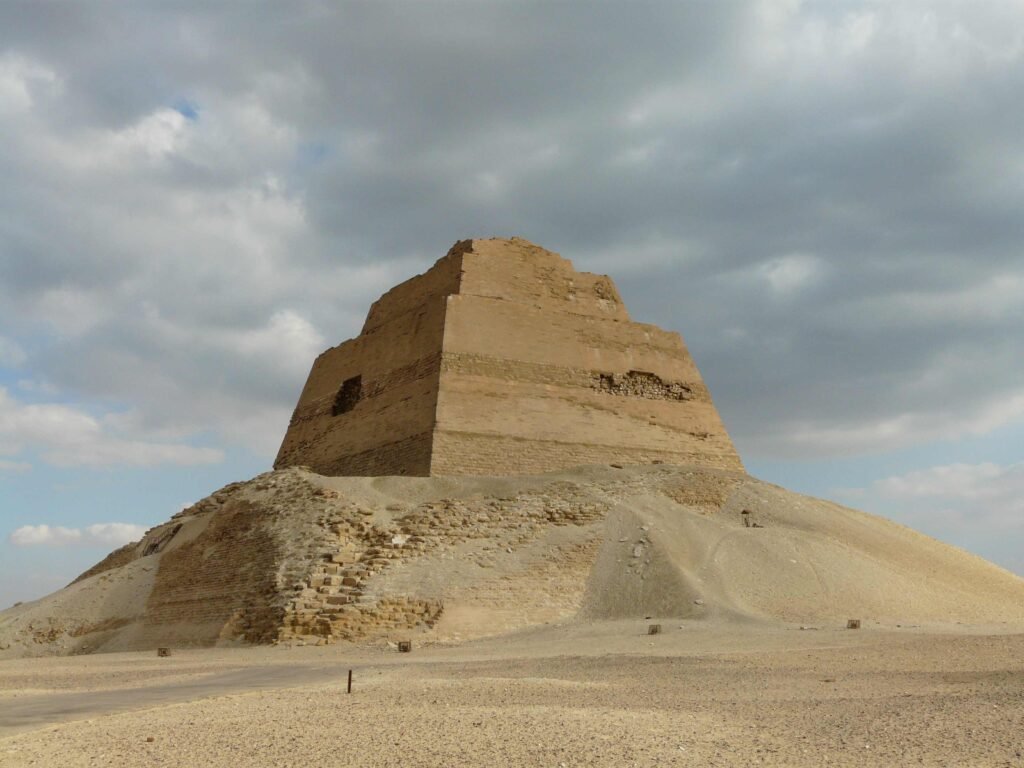
The Meidum pyramid was built in 2620 BC and is the first complete form of the pyramid in the Old Kingdom era, as it was built in The beginning is a mastaba built on a square and its entrance is from the north and it consisted of seven steps, of which only four remain now with a height of 45 meters and the entrance is at a height of 20 meters from the ground.
The entrance leads to a long corridor 57 meters long and then the burial chamber and on the eastern side of the pyramid is the funerary temple.
The Meidum Pyramid is considered the fifth largest pyramid in Egypt when it was built and it seems that this pyramid was not intended to be a tomb for Sneferu but rather to be a tomb or a false pyramid.
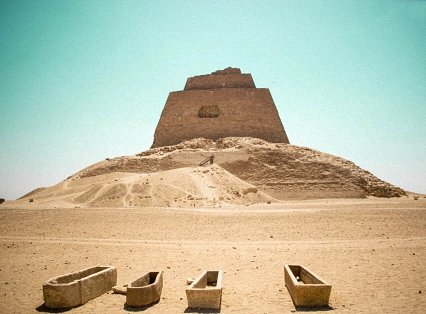
The Meidum Pyramid in the city of Al-Wasti in Beni Suef Governorate is also considered the first complete form of the pyramid in ancient times and it is a link between the stepped pyramids of the Third Dynasty and the complete pyramid of the Fourth Dynasty.
As is clear in the construction of the Meidum Pyramid, the history of the development of the stepped pyramid until it became a complete pyramid. As for the current shape of the pyramid, it represents the shape of a tower with three huge mastaba.
It is surrounded by high debris around the mastaba, indicating a major collapse that occurred to the outer layer of the casing as well as the stones that filled the terraces between The terraces and the stones used to build the pyramid were derived from a quarry about 800 meters south of the construction site
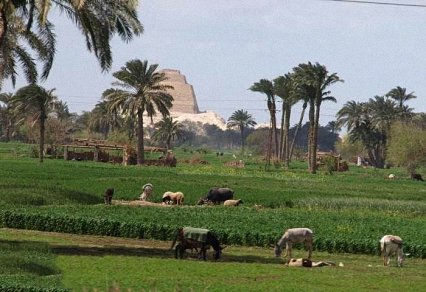
Name:
This pyramid is called Meidum in reference to the desert extension of the city of Al-Wasti, affiliated with the Beni Sobef Governorate, which is the area where the pyramid is located
which bears the same name and was not previously designated for royal tombs. The name Meidum or Huni in the ancient Egyptian language means beloved of the god Atum. It was transformed into Meidum after the Islamic conquest of Egypt and is also called in ancient Egyptian writing Djidi Sneferu
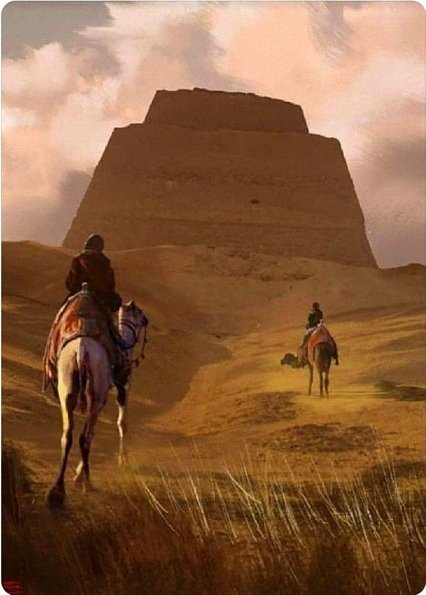
Sneferu:
Sneferu, known as Sawiris in Greek, according to Manetho, the founder of the Fourth Dynasty during the Old Kingdom. Estimates of his reign vary between 24 and 48 years
Sneferu’s reign was characterized by the expansion of foreign trade and sending disciplinary campaigns to maintain security and mining campaigns and searching for minerals. He and his engineer and advisor Imhotep reached the complete shape of the pyramid, where he built three pyramids that remain to this day and can be visited in Dahshur
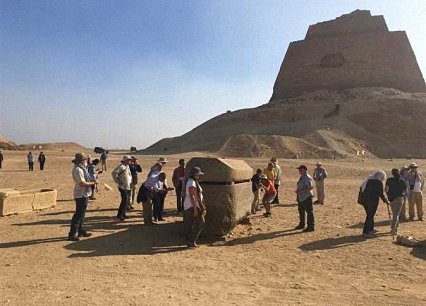
Architectural description of the Meidum pyramid :
The Meidum pyramid appears as a high platform surrounded by sand and rubble. When it was first built, it did not take the known pyramidal shape. It was a platform with a square base, with an entrance from the north.
It has several passages that eventually reach the burial chamber and the funerary temple, half of which is above ground level and the other half is below ground level. The pyramid consists of seven platforms.
Also read about : Maadi Island
Only four of them remain at present, with a height of 45 meters from the beginning of the first platform to its end. All its layers were covered with limestone. It consists of two rooms that open onto an open hall leading to the pyramid.
In the hall there is an offering table and two large stone panels with no writings on them. The dimensions of the two rooms are 9 meters by 9.18 meters. Their roofing stones are still in place, making it the oldest complete roofing found for a building in the Old Kingdom. The pyramid from the inside is a burial chamber to which a sloping passageway descends.
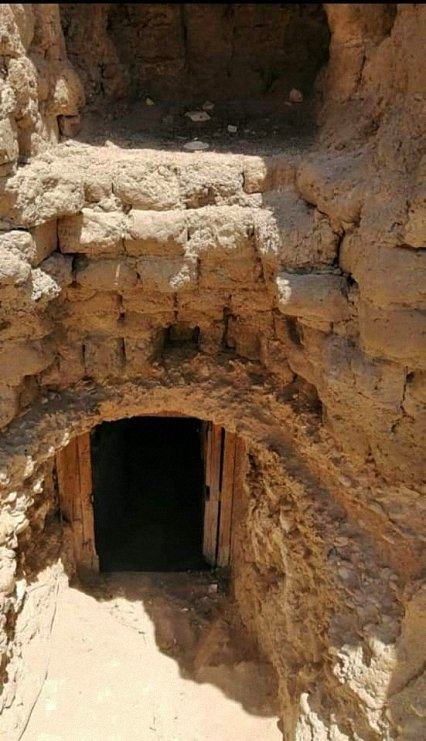
This sloping passageway is built of limestone in an open pit and trench. This work may have been invented due to the poor quality of the rock in Meidum. The entrance is located at a height of 30 meters above the ground.
It leads to a long passageway 57 meters long, then the burial chamber. On the eastern side of the pyramid is the funerary temple. The architectural style of this pyramid is called the layered pyramid. It differs from the stepped pyramids and is considered a transitional stage to the complete pyramid. Some scholars believe that its collapse was recent in the advanced families after its completion.
There are those who believe that it was not completed at all, as a result of the fact that during the reign of King Sneferu, during the construction and work on the pyramid, a major collapse occurred in its outer layer, and work on building the pyramid stopped.
The walls of the funerary temple were left Empty without writing on it, but scientists agreed that Sneferu, after completing the construction of the Meidum pyramid or abandoning it after its collapse, built four other pyramids, and therefore he is called the greatest Egyptian builder for about 4650 years. These pyramids took the shape of a regular pyramid, not a cube.
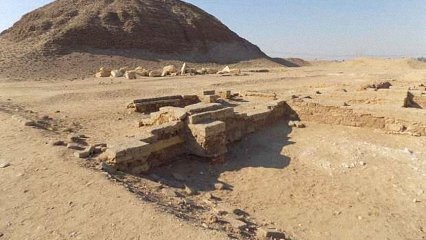
Layers of the pyramid:
The pyramid was formed in three stages. In the beginning, the Meidum pyramid, located in the Wasiti Desert in the Meidum area, consisted of seven complete layers.
Then a layer of shiny limestone was added. After about ten years, the sides of these terraces were covered with soft white limestone.
As its external appearance became like the shape of the complete pyramid known to everyone, and the length of each side of this pyramid, the subject of research (Meidum), is about 144 meters.
Its height is 92 meters, and only three steps remain, with a height of about 33 meters. The two inner layers were not well intertwined with each other, as the outer cladding of the pyramid, which consisted of shiny white limestone, collapsed completely. There are still traces of the collapse of the cladding next to The Pyramid

Entrance to the Pyramid:
The entrance to the pyramid is located at a height of 25 meters on the north side and leads to a 57-meter-long downward sloping entrance. Near the bottom of the slope there is a stone whose purpose is unknown. It is believed that there was a wooden door at the end of the sloping passageway, the traces of which are visible. There are two small halls, each 8.5 feet wide and 4 feet deep, the first on the eastern side of the passageway and the second on the western side. It is believed that the halls were used during the construction of the pyramid to store stones that are difficult to lower into the passageway. The area of the hall is sufficient to move large stones. At the end of the passageway there is a vertical well that reaches the burial chamber.
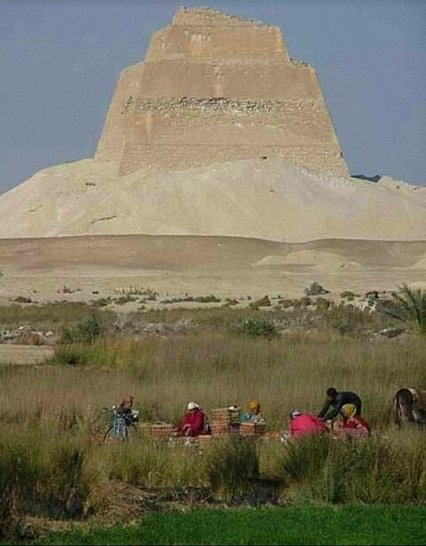
The burial chamber:
The burial chamber is located at the end of the passageway. We find that this chamber is located on two different levels. The first part is underground and the other part is above ground. Inside there is the first mastaba.
The area of the chamber from north to south is 5.90 meters and from east to west 2.65 meters. The ceiling of the burial chamber has wooden supports and consists of 7 layers mounted on top of each other at a height of 5.5 meters. There are also holes in the ceiling to place the wood veins that were used during construction. The floor was paved with limestone blocks, some of which have been removed from their place.
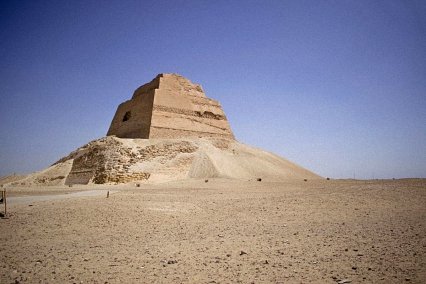
The ascending road:
The ascending road extended between the pyramid and the valley temple. Ceremonies were held there after the king’s coffin left the funerary temple heading to the pyramid. The coffin was carried by some priests and another group of priests carrying incense on both sides of the tabun. The priest chanted religious hymns and texts during the passage of the king’s coffin procession from the temple to the pyramid on the ascending road. Behind the high priest was a group of chanting priests, who chanted in addition to religious dancing, which was part of the religious rituals and was performed by dedicated dancers.
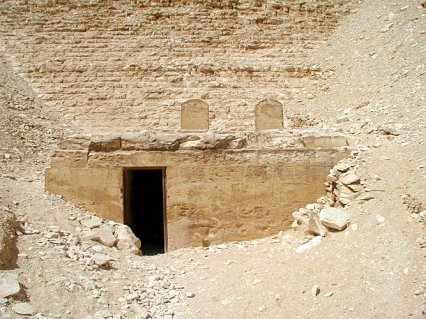
The funerary temple of the pyramid:
The funerary temple is located on the side The eastern side of the pyramid is the first funerary temple built on the eastern side of the pyramid
The temple is considered, from a planning perspective, a new addition to the temples of the ancient Egyptian state. This temple consists of an open courtyard adjacent to the walls of the pyramid
In the courtyard of the temple there is an offering table in the form of the Hetep sign, symbolizing the offering of sacrifices, obedience to the Lord, and stability. It is surrounded on the side by a large limestone slab with a round top, then two halls, then the entrance connected to the ascending road
Archaeologists found, while carrying out their work in the first hall, inscriptions, some of which date back to the Old Kingdom
And some of these inscriptions date back to the modern state. They found that the most important inscription drawn in it
It was dated in the forty-fifth year of the reign of King Thutmose III, sent to the writer “Aa – Kheber Kare – Seneb” and mentions that he came to see the beautiful temple of Sneferu. The roof of this temple was found in good condition, and a small wall surrounds the temple
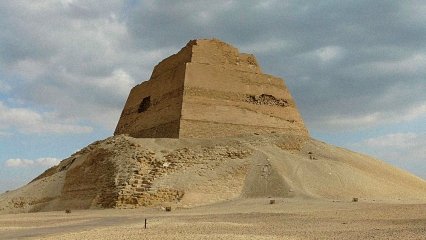
Valley Temple:
The Valley Temple is located near the group The Meidum Pyramid was called the Valley Temple because of its proximity to the vast agricultural lands surrounding the Nile Valley.
During the excavation process, important documents were found indicating that the temple was located in this place, as recent discoveries have proven that this entire temple is underwater, making it difficult for specialized workers to discover all its submerged parts.
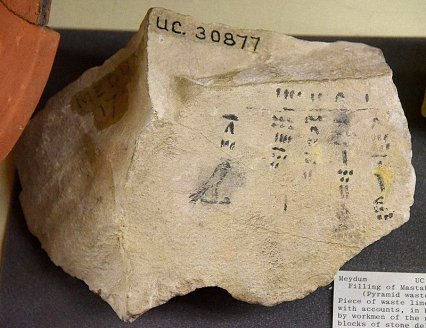
Developments and discoveries made in the pyramid:
Development work was carried out in the Meidum Pyramid, where the wooden staircase leading to the entrance to the pyramid was changed, as some of its parts were suffering from deterioration.
Others needed support, which led to the entire staircase being changed. The pyramid door and the funerary temple door were cleaned and restored, and new signboards were made.
In Arabic and English, in 1980 AD, the scientist “Petri” discovered parts of a wooden coffin inside the burial chamber.
It was believed that it belonged to King Sneferu. In 1891, “Petri and Weinert” continued excavating, and the Valley Temple was discovered.
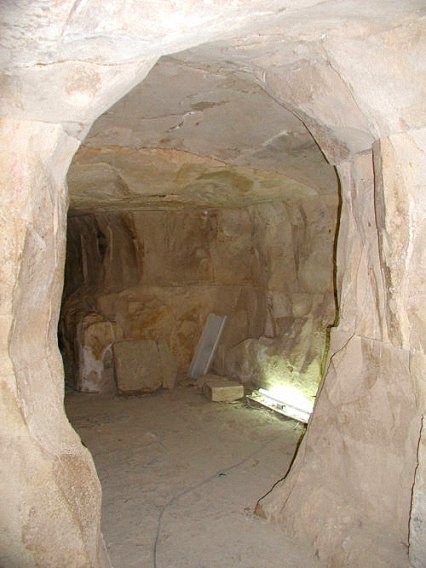
And published Petrie wrote two books for these excavations, containing all the information about the area. Petrie found some names of the teams that were working on the pyramid, and found a copper axe with the name of one of the craftsmen on it in 1927. The scientist “Borkhardt” examined the Meidum pyramid.
He wrote an article containing the most accurate schematic drawings of this pyramid (Meidum). The side of the Meidum pyramid was expanded to one hundred and forty-seven meters.
So that the height of the pyramid upon completion became ninety-three meters, which makes it ranked fifth among all the pyramids of Egypt in terms of height.
The volume of the Meidum pyramid reached 638,733 cubic meters, but it is not completely known whether the third phase of construction was completed, and perhaps some construction platforms were left in the past, which made it easier to take the stones of the pyramid to build other buildings.
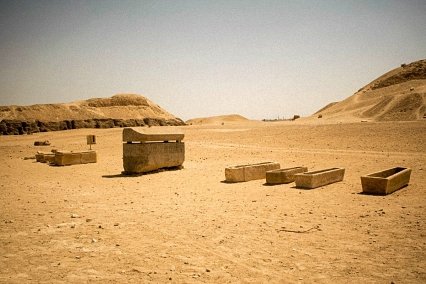
The underground structure:
The design of the lower structure of the pyramid takes a new approach compared to the Saqqara pyramid, which was built before it. The funeral chamber was raised to the body of the pyramid.
The underground parts were not built by excavation In the rock only, but a long open hole was built for it, lined with existing stone blocks.
The entrance to the pyramid is located on the northern facade at a height of 18 meters, and from there begins an entrance with a height of 1.5 meters and a width of 0.90 meters to the bottom. After a short entrance to the bottom, there is a deep well that was perhaps to receive water that might leak from the pyramid.
This is to prevent water from entering the other chambers. The entrance ends with a first chamber with two right and left corners with a height of 1.7 meters

And their dimensions are 2.60 meters x 2.20 meters. From here, a second chamber branches off with dimensions almost the same as the first chamber (2.65 m x 2.10 m).
It is located on the right side of the entrance. Both entrance chambers have a low ceiling and the ceiling of each chamber is covered with wide, stacked, intact stones
It has no cracks. Perhaps the entrance chambers were closed with a large stone that flows from the side corners of each chamber. The German archaeologist “Stadelman” sees in this the system of the three chambers
which was followed in the design of the pyramids later during the Fourth Dynasty. From the second entrance chamber, a new corridor with a length of 4.5 meters begins, then a vertical opening upwards leading to the main chamber. The dimensions of the funeral chamber are 5.90 meters x 2.65 meters and a height of 5.05 meters. It is in the direction of north and south
And the roofing with A stepped dome distributes the pressure of the pyramid on both sides of the funeral chamber. There is no coffin in the main chamber.
There are no traces indicating the presence of a coffin in it before. There are also large wooden panels in the room and also in the corridors.
Perhaps it was for the purpose of transporting the wooden coffin to the funeral chamber. There are also no storage spaces in the entrance system or in the rooms, unlike their abundance in all the pyramids of the Third Dynasty.
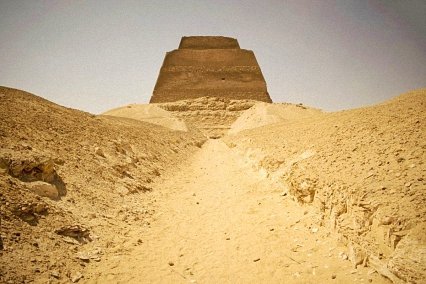
The pyramid complex:
The pyramid complex was surrounded by a wall 2 meters high, 236 meters long and 218 meters wide in the east direction. Nothing remains of it except the remains of a slide.
It is believed that the purpose of the wall was to reserve a place for other buildings that were built later. The hall around the pyramid was paved with dry mud.
The funerary temple, which was completed during the second phase, and nothing remained of it, so taking its place became necessary to build the third phase of the pyramid.
It is believed that the location of this temple was east of the pyramid. The pyramid temple consists of two rooms that open onto an open hall leading to the pyramid. There is an offering table in the hall. Two large stone panels with no inscriptions. The dimensions of the two rooms are 9 meters by 9.18 meters. Their roofing stones are still in place, making it the oldest complete roofing of a state building. There are no storerooms in the two rooms of the funerary temple.
As is customary in large funerary temples, the good condition of the funerary temple is due to it being hidden under the rubble.
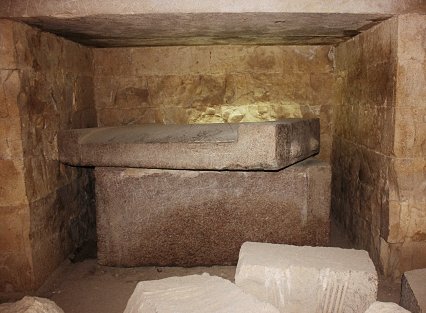
As for the worship pyramid, there is a small secondary pyramid to the south of the Meidum pyramid. The archaeologist “Petri” found its remains, and it represents the oldest example of a worship pyramid.
The structure that was high for the pyramid disappeared, and its underground plant was demolished. The archaeologists “Vito Maragioglio” and “Celeste Rinaldi” reshaped the remaining parts, which indicate the existence of a previous step pyramid with a side of 26 meters, consisting perhaps of three or four terraces on top of each other. The structure of the pyramid was made up of inward-sloping stone layers.
As is found in the structure of the Meidum pyramid, as historians mentioned, the design was The underground structure of the small pyramid is completely similar
to the infrastructure of the Meidum pyramid in the city of Wasti, as we mentioned before. There is an inclined entrance from the pyramid leading north to the main chamber. Research and excavation operations at the site of this small pyramid revealed a large limestone plaque with an engraving of the god Horus on it.

Historians have seen the Meidum pyramid:
It has been proven that the Meidum pyramid has a special and unique shape and design. At first glance, some think that it is similar to the step pyramid
that King Zoser built in Saqqara. It was covered from the outside with a layer of white lime, but in reality it did not take a pyramidal shape.
It appears in the middle of the desert in the form of huge cubes consisting of three steps on which a layer was placed that made it a flat pyramid
to the point of making it similar to a real pyramid. More than six decades ago, specifically before the year 1430 AD
The Sheikh of Egyptian and Arab historians, Taqi al-Din al-Maqrizi, described the Meidum pyramid as five steps, which made some

believe that the pyramid was two steps larger than that and that An earthquake led to its collapse. Historians believe that this collapse occurred during the advanced families after its completion. Others believe that the pyramid was not completed due to a collapse in the outer layer during work on it, turning it into a marvel among the Egyptian pyramids. Historians also believe that King Sneferu completed the construction of the Meidum Pyramid. This is due to its proximity to his seat of government, “Gedi Sneferu,” which is located near the city of Meidum, although this area was not previously designated for royal tombs. Egyptian engineers chose it because it is located on top of a rocky plateau, which made it qualified to withstand the pressure of a huge pyramid, in addition to its proximity to the Egyptian capital. The plateau also includes a funerary temple, terraces, and a sloping road leading to another temple that was built near the Nile River Valley, which means that it is a rich and eye-catching area that can be exploited for tourism to a large extent.
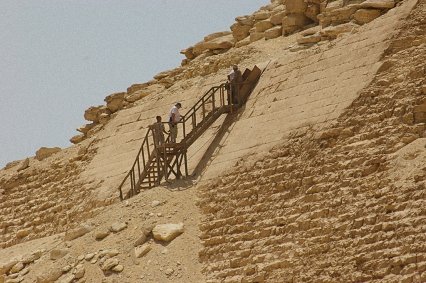
Development of the Meidum Pyramid Area:
The Beni Suef Antiquities Area has begun development work on the Meidum Pyramid Antiquities Area as part of the Ministry of Antiquities’ plan to develop the areas Archaeological
And make it more attractive to foreign and domestic tourism by providing the services that visitors need while preserving the sanctity of the archaeological area
As the development work included changing the wooden staircase leading to the entrance to the Meidum Pyramid, as some of its parts were suffering from deterioration
And others needed support, which required changing the entire staircase. The pyramid door
And the door of the funerary temple were cleaned and restored. The development work also included making new signboards in Arabic and English, in addition to renewing the trash cans in the area. The Meidum area includes, in addition to the famous pyramid, a funerary temple, terraces, and a sloping road leading to another temple. Therefore, the area is very rich
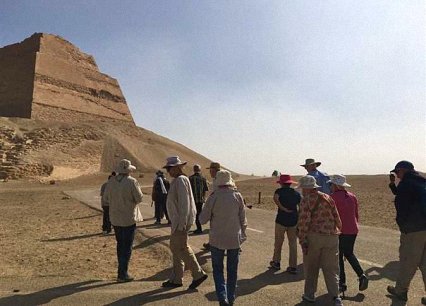
And the focus of attention and can be exploited for tourism in a big way, as it is currently being developed to transform it into a civilized breathing space and a tourist attraction area
Important works are being carried out to give the entire area a civilized and distinctive look and prepare it to receive visitors
By supporting it with basic services and needs in preparation for comprehensive development within the tourism development strategy, the large hall was developed and equipped for the possibility of converting it into an archaeological museum that explains the archaeological importance of this area

Which contains the Meidum Pyramid, which was completed by Sneferu, the father of the founder of the Fourth Dynasty, which is considered the first complete pyramid and is older than the Giza Pyramids and famous tombs such as the Mastaba of Nefermaat, in addition to the possibility of holding bazaars through which papyrus papers and the most important Pharaonic and archaeological collections are displayed. The open area of the oasis has also been equipped by equipping a cafeteria and a restaurant that serves traditional and popular meals that distinguish the governorate and are considered part of its traditions and cultural heritage, and equipping an area for horses, camels and war chariots, and beautifying the oasis by pruning trees, installing ornamental plants and flowers, and raising the efficiency of basic services, as the efficiency of the toilets in the oasis has been raised. The unusual shape of the Meidum Pyramid, which is located north of the city, attracts Al-Wasti in Beni Suef Governorate attracts the attention of visitors who call it the “false pyramid”, from which three terraces are currently visible and Beni Suef Governorate has adopted it as its logo.
Source : egyptian1
It is one of the pyramids of the Old Kingdom during the reign of King Sneferu of the Fourth Dynasty in Meidum 2620 BC
Read More :
- The Meidum pyramid, the royal tomb of king Sneferu
- The Architectural Splendor of Al-Mu’izz Mosque
- Tabali Egyptian street food restaurant in New Cairo
- The Coptic Museum in Egypt
- Dive into the Mysteries of Heraklion: The Lost City Beneath the Waves

